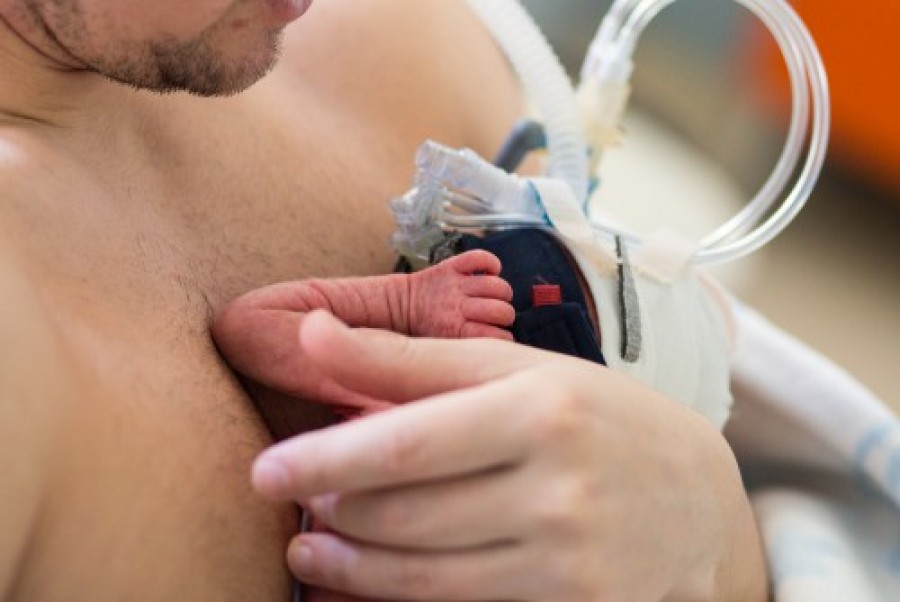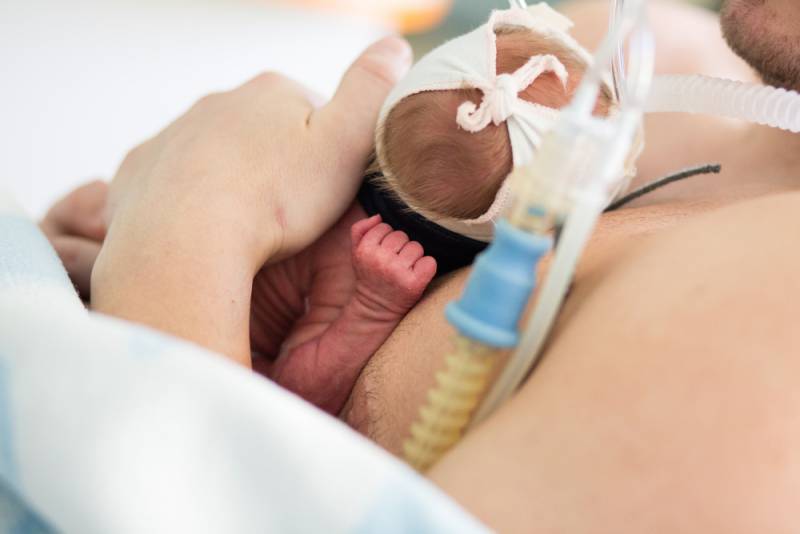Kangaroo Mother Care for Preemies

Ideally, a baby spends approximately 38-42 weeks in the womb growing and developing to prepare them for life outside of their mother. Unfortunately, sometimes something goes wrong and babies are born prematurely. Any baby born before 37 weeks gestation is considered to be premature. Sometimes premature babies are called “preemies” for short. Preemies have a considerably higher chance of medical complications compared to babies that are born at full term. They almost always require a longer hospital stay. Depending on how far along the pregnancy is when the baby is born, they may require hospitalization for weeks, months or in very extreme cases over a year. One wonderful thing that can be done for premature babies is kangaroo mother care.
What is Kangaroo Mother Care?
Kangaroo mother care, often simply referred to as kangaroo care or sometimes even kanga care, is basically just the practice of holding your premature baby skin to skin on your chest underneath your clothes or a blanket. Skin to skin contact is greatly beneficial to all babies including healthy ones, but holds a special place in the care of premature babies. It helps them in many ways and can reduce their hospital stay as well as improve their overall outcomes.

History of Kangaroo Mother Care
Problems in a Columbian neonatal unit in the twentieth century led a doctor to implementing kangaroo mother care for the first time.
1. Problems Leading to Kangaroo Mother Care
In the 1970s, the Mother and Child Institute in Bogota, Columbia was experiencing a disturbingly high death rate amongst premature babies. It was the largest neonatal unit in all of Columbia with approximately 30,000 babies born there each year. There was a shortage in doctors, nurses, and incubators. Typically, 3 babies would have to share a single incubator and the rates of infection were very high. A doctor named Rey came up with a solution after learning about how kangaroos are born and nurtured by their mothers.
2. Physiology of Kangaroos
Baby kangaroos are born very immature and are usually about the size of a lima bean at birth. They crawl into their mother’s pouch and spend the first 8 to 11 months or so there. Once they enter the pouch they immediately latch onto their mother and nurse consistently. The mother’s body continues to provide temperature regulation. The way that kangaroo mother’s care for their tiny immature babies peeked Dr. Rey’s interest and he decided to try a similar approach with premature human babies.
3. Success of Kangaroo Mother Care
Dr. Rey began instructing the mothers of preterm babies to carry them similarly to kangaroos. He also stressed the importance of breastfeeding and they began to send premature babies home earlier in the care of their mothers who had instructions to continue the practice of kangaroo mother care. Success was seen immediately. The death rate began to drop significantly as did the amount of infection. Since then, kangaroo mother care has gained great popularity and spread throughout the globe.

Benefits of Kangaroo Mother Care
There are many benefits of practicing kangaroo mother care with your premature baby. Benefits range from physical to emotional and studies show that kangaroo mother care even saves lives.
1. Temperature Regulation
One of the many struggles of a premature baby is being able to properly regulate their temperature. This has to do with their immaturity and lack of body fat. When a baby is placed on its mother’s bare chest skin to skin, her chest automatically adjusts its temperature to whatever temperature is needed to regulate the baby to the correct temperature. This makes Mum’s chest the perfect “incubator” for baby.
2. Regulation of Other Body Functions
On top of helping to regulate the temperature of the body, kangaroo mother care can also play an important role in regulating other aspects of a baby’s body functions. This can include keeping a steady heart rate as well as breathing pattern. It also helps to regulate a baby’s blood sugar and blood pressure.
3. Mother and Baby Bond
The skin to skin time during kangaroo mother care provides an amazing opportunity for mums to bond with their little bubs. Keeping your little one close helps both of you to get to know each other and helps to lower stress and improve mood.
4. Higher Chance of Breastfeeding Success
Studies show that kangaroo mother care heightens the chance of a successful breastfeeding relationship. This skin to skin time during kangaroo mother care allows the baby optimal time to learn how to breastfeed properly. It also stimulates the production of oxytocin which is an important hormone for bonding and breastfeeding.
5. Less Crying
An infant, premature or not, cries less when they are able to consistently be close to their mother. This reduced crying is especially crucial for premature babies. By helping to prevent a baby from crying, you are reducing the amount of stress the baby experiences which helps them to put every bit of their precious energy into the very important growing and developing they have to do.
6. Increased Sleep
Being on their mother’s chest makes a baby feel very safe and warm. This security achieved through kangaroo mother care allows a baby to get plenty of sleep which is completely crucial to their proper development.
7. Parental Benefits
Kangaroo mother care is not just good for the babies, but is also good for the parents of the babies. Not only does it help to increase breastmilk supply in mothers, but it also helps you feel more in control of the situation and allows you to care for your baby yourself. It often also increases the confidence parents have in their ability to properly care for their children.
8. Other Benefits
Studies also reveal that premature babies whose parents practice kangaroo mother care also experience the following benefits:
- Better oxygen saturation
- Faster weight gain
- Shorter hospital stays

Does Mum Have to be the Exclusive Provider of Kangaroo Mother Care?
Mums are certainly not the only ones that are able to provide this wonderful form of care for their sweet bubs. Anyone can do kangaroo mother care with your baby. It’s a good idea to take turns with your partner or possibly even other family members so that you can provide optimal amount of uninterrupted kangaroo mother care time for your little one but also take care of yourself as well. Taking turns also provides a good opportunity for your partner to bond with your baby.
How to Perform Kangaroo Mother Care?
Kangaroo mother care is very simple and easy to learn how to do. Depending on your place of birth, you may be taught how to perform kangaroo mother care by the staff. Even without that help though, kangaroo mother care is very easy to do. You simply place your baby with their chest against your chest. For women, you’d place the baby high up in between the breasts. For men, the baby should be placed in a similar position in the center of the chest. The chest of the person performing the care should be completely bare and the baby should be wearing nothing more than a nappy and perhaps a hat to ensure optimal skin to skin contact. Generally, the adults clothing or a blanket should be placed over top of baby.
Focus on Your Baby
The newborn period can be a fragile time in any baby’s life but that is even more true with a preemie. The role you play during this time can deeply affect every aspect of life for your little one. To give your baby the best chance of survival and good development, spend as much time as possible doing kangaroo mother care with your baby. Consider taking some time off of work if at all possible and do whatever you can to spend as much time with your bub as you are able to. You will never regret spending this time with your precious little bub.



